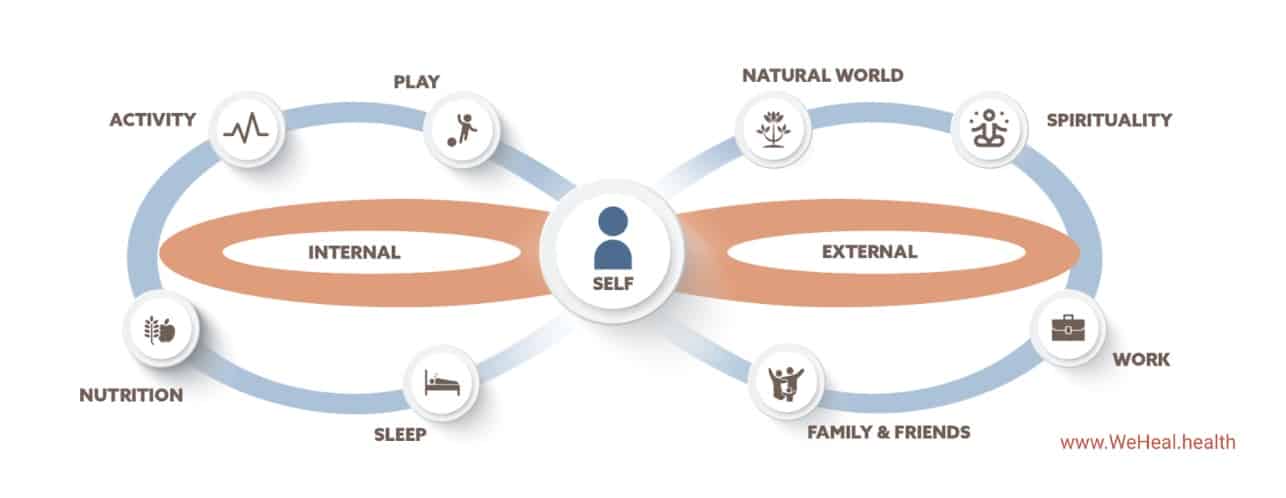

Our journey began with conventional medicine before branching into nutrition and lifestyle medicine focused on nutrition, sleep, physical activity, and achieving overall well-being. And there we lived for quite some time. Our biomarker numbers (blood pressure, cholesterol, etc.) looked great. And so did our patients’ numbers. But life was still far from wonderful. Despite our clean diet, exercise regimen, and nearly perfect sleep schedule, we continued to face issues: chronic stress, disconnection in personal relationships, chronic pain, gastrointestinal symptoms, and other challenges. Again, so did our patients.
As lifelong learners passionate about health and wellness, we had to acknowledge that we were not where we wanted to be. Despite teaching wellness, we still felt depleted, tired, stressed, and disconnected. We aspired for something more. What if there was a way to feel more energetic and connected to ourselves and our loved ones? What if we had the skills to regulate and resource ourselves to manage stress? What if life felt expansive with ample opportunities for joy? In short, what if life was wonderful?

At first, that goal seemed lofty. So many of us live in survival mode, burning the candle at both ends. We regularly stress about our families, work, bills, and more. A state of wonderful feels out of reach. Too good to be true. From patients, we often hear something along the lines of, “I’m barely keeping it together and you want me to think about . . . wonderful?”
But why not? In a world of infinite possibilities, why can’t life be wonderful? This question inspired the model we call Essence of Weheal (EoW). Over the last several years, we have been on a mission to identify, simplify, and solidify the path toward a state we now call Life is Wonderful. The fruits of this labor have culminated in our newest and most important book, Wellness to Wonderful.
The EoW model offers a continuum through which we can track nine pillars of health, well-being, and joy. The pillars are centered around you (self). They include areas in your life that you can improve independently (sleep, nutrition, activity, and play) and areas in your external world (family, friends, work, spirituality, and the natural world).

By prioritizing a state of Life is Wonderful, everything else falls into place. Simply put, chronic disease has no fuel when you optimize your EoW.
Underneath the nine pillars, we emphasize three elements: resourcing, connection, and regulation.
Resourcing includes much of what is traditionally called “wellness.” It is all about optimizing our internal world to “fill up our tank” so we can feel refreshed and energized. When you are resourced, it is easier to care for yourself and achieve your goals. But if you stop at resourcing, you often find that something is still missing, even if your numbers look great.
Regulation is what allows us to feel safe and calm. This is a particularly important skill to hone in our fast-paced world, where chronic stress is so common. When we mobilize our bodies into a high-alert state, we turn on pro-inflammatory pathways at the cytokine, hormonal, and vascular levels. This response is great for tending to acute tissue damage, but it is extremely harmful when chronically activated in response to emotional, mental, or spiritual pain. Persistent states of stress are associated with chronic pain, a host of inflammatory diseases, heart disease, anxiety, depression, obesity, reflux, colitis, other gastrointestinal issues, an impaired immune system, and difficulty coping with adversity. Regulation—through practices that enhance presence, awareness, and mindfulness—helps us rewire our brains and change our environment to shift from messages of danger to messages of safety, an essential piece to optimizing health and achieving a state of Life is Wonderful.
Connection encompasses our most important relationships. Although some consider meaningful connection a “nice-to-have,” it is essential. Data shows that empathic connection affects your physical health, including levels of LDL, Hemoglobin A1c, and acute metabolic complications in diabetics.[1][2] It even appears that people who suppress their emotions have a less diverse gut microbiome; in other words, your ability to navigate emotion impacts the ratios and types of bacteria in the microbiome. Women who reported being happier, more hopeful, and with better emotion management skills had a more diverse (healthier) microbiome.[3]
What’s more, all of the elements of the EoW affect each other. For example, when we don’t get enough sleep, we feel tired and it becomes more difficult to be patient with loved ones. Studies show that sleep deprivation also increases our craving for sweets, processed carbs, and salty snacks by roughly 30–40 percent! It even upsets our hormonal balance to increase ghrelin (signals “I’m hungry”) while simultaneously decreasing leptin (signals “I’m full”).[4][5]

We illustrate the EoW as an infinity loop to designate the flow and interdependence between each pillar. Let’s dive deeper into how they contribute to a state of Life is Wonderful.
- Self: discerning what you are feeling inside and what your needs are so that you can share your desires authentically and take steps to meet your needs while also caring for the needs of others.
- Nutrition: eating a diet in which as many calories as possible come from whole plant foods or dishes whose ingredients are whole plant foods.
- Activity: moving regularly to ensure optimal flexibility, balance, strength, and endurance.
- Play: time for recreation where you are present and enjoying the moment without pressure or any sense of obligation or requirement to accomplish anything.
- Sleep: getting adequate rest, in quantity and quality, so you wake up refreshed and restored.
- Family & Friends: having relationships where you can experience compassionate authenticity (being honest while also being mindful of the impact you have on others) instead of artificial harmony (suppressing your feelings and needs to keep the peace).
- Work: contributing to your community and society in ways that meet your needs for meaning and purpose.
- Spirituality: being connected to something bigger than yourself, valuing interdependence—knowing that we are all waves in the same ocean—and believing that you can’t meet your needs at the expense of others.
- Natural world: connecting to all other life on this planet and caring about the impact your actions have on the world around you.
The EoW is not a static destination. It is a dynamic flow of life happening in every moment. Your EoW could be optimized today and completely out of balance tomorrow. The pillar that needs attention right now might be different than the pillar that needs attention tomorrow. The key to living in a state of Life is Wonderful is to be aware of and regularly tend to the nine pillars. The goal is persistence, not perfection; it is about being able to identify when you fall off the path and knowing how to get back on.
Sadly, most people have lost connection with themselves and their authenticity. They become used to receiving ideas about what is right or wrong (or good or bad) from their parents, teachers, bosses, etc. As a result, discerning what they are feeling and needing and acting in alignment with their values is a foreign concept. Not only does this encourage feelings of depression and anxiety, but it also makes them dependent on others telling them how to be healthy and happy.
That is why we emphasize that tending to the EoW is not a quick fix, life hack, or magic bullet. It requires work and an authentic relationship with yourself. An analogy to help make this point is that you could theoretically avoid the effort of raising a child by adopting an 18-year-old and then sending them to college. But it is within the effort of those first 18 years of raising your child that the magic lives.
With this new awareness, you have the ability and drive to begin connecting to your internal values, letting them guide your actions. Embarking on this path leads you to experience that Life is Wonderful. And the best news is that when you transform your life in ways that align with the Life is Wonderful paradigm, the effort gets easier over time. By creating new neural pathways, you begin to replace old habits.
So, what are you supposed to do if you aspire to raise the bar above the baseline (which is often mediocre at best) or normal (which in today’s world is still quite unhealthy and unhappy)? In most healthcare models, they start by asking what is wrong, but at WeHeal, we start by asking, What does Life is Wonderful look like to you? We focus on where you want to go, not where the problem is or what is to blame. Because you can’t get to where you want to go by only focusing on where you don’t want to be, just like you can’t learn Spanish by only avoiding English.
Try it right now: take a minute to imagine one action you could take today that will increase the chances that when you go to bed tonight you say to yourself that today was a wonderful day. Create that target and go for it. Even if you miss, life will be more wonderful just by trying.
References
- Hojat M, Louis DZ, Markham FW, Wender R, Rabinowitz C, Gonnella JS. Physicians’ empathy and clinical outcomes for diabetic patients. Acad Med. 2011 Mar;86(3):359‐64. Doi: 10.1097/ACM.0b013e3182086fe1. PMID: 21248604.
- Del Canale S, Louis DZ, Maio V, Wang X, Rossi G, Hojat M, Gonnella JS. The relationship between physician empathy and disease complications: an empirical study of primary care physicians and their diabetic patients in Parma, Italy. Acad Med. 2012 Sep; 87(9): 1243‐9. doi: 10.1097/ ACM.0b013e3182628fbf. PMID: 22836852.
- Ke S, Guimond AJ, Tworoger SS, et al. Gut feelings: associations of emotions and emotion regulation with the gut microbiome in women [published online ahead of print, 2023 Mar 21]. Psychol Med. 2023;1-10. doi:10.1017/S0033291723000612
- Kracht CL, Chaput JP, Martin CK, Champagne CM, Katzmarzyk PT, Staiano AE. Associations of Sleep with Food Cravings, Diet, and Obesity in Adolescence. Nutrients. 2019 Nov 30; 11(12): 2899. doi: 10.3390/ nu11122899. PMID: 31801259; PMCID: PMC6950738.
- Greer SM, Gold‐ stein AN, Walker MP. The impact of sleep deprivation on food desire in the human brain. Nat Commun. 2013; 4: 2259. doi: 10.1038/ncomms3259. PMID: 23922121; PMCID: PMC3763921.
Copyright 2024 Center for Nutrition Studies. All rights reserved.
Earn Your Plant-Based Nutrition Certificate
Join over 20,000 students who have improved their health, learned new skills, and even inspired career changes.
Program Overview
- 23,000+ students
- 100% online, learn at your own pace
- No prerequisites
- Continuing education credits










